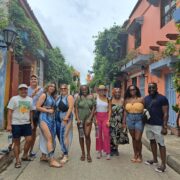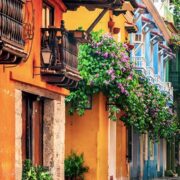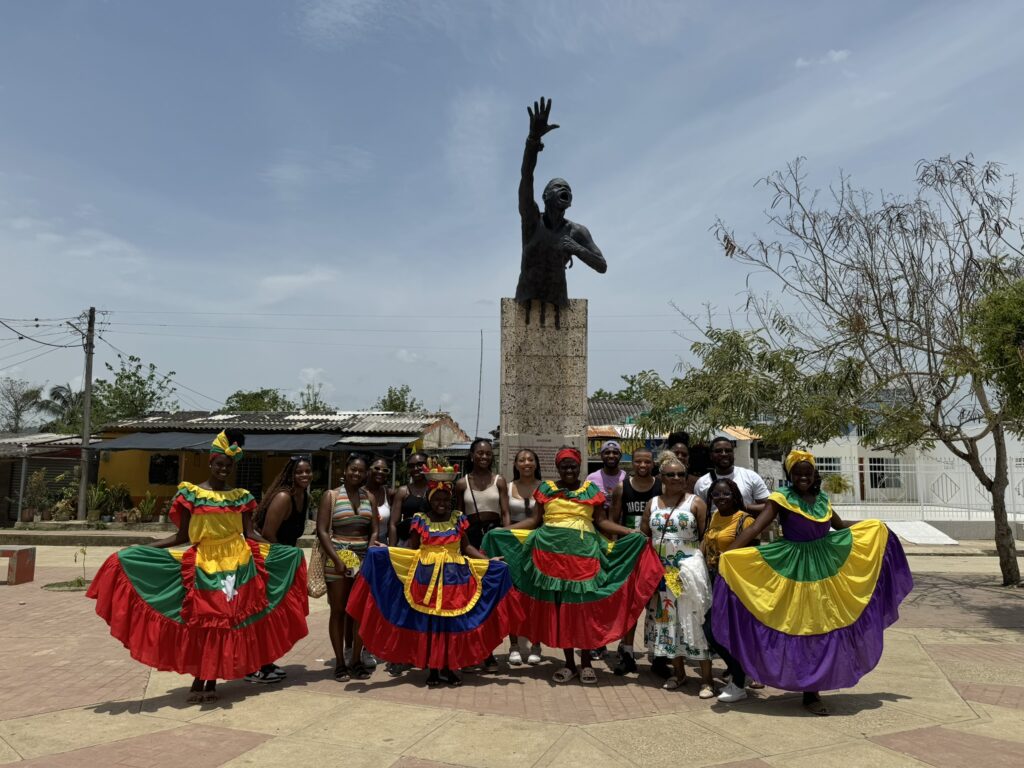
San Diego neighborhood: An unmissable place to visit in Cartagena
When we think of Cartagena de Indias, images of a vibrant Caribbean destination full of color come to mind. With its beautiful streets, historic churches, and charming houses, Cartagena de Indias is the number one destination for travelers in Colombia. That’s why I’ve written this blog to share with you the must-see historical spots in Cartagena’s San Diego neighborhood.
Introduction to San Diego Neighborhood
To start, let’s talk about my favorite neighborhood in the old city: San Diego. Back in the day, this was a low-class neighborhood, but today it’s known for its beautiful villas, bohemian atmosphere, and the lively San Diego square at night.
San Diego is the perfect place to get lost in its narrow streets and admire the stunning republican and colonial architecture, with facades adorned with beautiful flowers. This neighborhood was originally built close to Cartagena, though it wasn’t initially part of the city.
At that time, it was significant because it was easy to access fresh water, a crucial resource in a city surrounded by the sea. Originally named the neighborhood of Jagüeyes (Ponds), it was first inhabited by the Kaimaries indigenous people. Over time, this group vanished, and the area where San Diego now stands became part of Cartagena.
In 1580, many people with licenses to live in the city, along with a large number of slaves, moved to San Diego. Cartagena was expanding, and these new inhabitants helped build houses and worked in agriculture, taking advantage of the abundant water resources.
Unique Architecture of San Diego
In 1611, the Convent of San Diego was founded, marking a significant development for the area. The convent provided a much-needed place of worship for the poor residents, who previously struggled to attend mass due to the long distance from the main churches in the city center. The houses in San Diego were built smaller compared to other parts of the historic center. Since the land here is higher, and the city wall had not yet been built, the houses didn’t need high balconies or second floors to catch the sea breeze. Most of the homes in San Diego are single-story.
San Diego’s Growth and Integration
In 1621, San Diego was officially integrated into the city under the name Santo Toribio, and the Convent of Santa Clara was built. Due to frequent storms that battered this part of the city, engineers responsible for fortifications decided to build a section of the wall from the Baluarte de la Merced to Baluarte de Santa Catalina.While the population of San Diego wasn’t considered marginalized, it was primarily composed of low social class residents, including free and enslaved Black people, Spanish artisans, and traders. The free and enslaved Black population formed cabildos, which were spaces for socialization and cultural exchange.
Gentrification in San Diego
Nowadays, the residents of San Diego face gentrification, with many traditional families being forced to move out due to the high cost of living in this historic neighborhood. Foreigners with significant purchasing power are buying the single-story houses in this picturesque neighborhood, turning them into villas for rent. Convents have become five-star hotels, and homes have been converted into bars, restaurants, and coffee shops. The authentic local atmosphere of San Diego is slowly fading away. Many long-time residents resist leaving this place, which holds deep cultural significance for the city, especially in the realm of salsa music. In the ’90s, San Diego was the perfect spot for a salsa night.
Historical Memories of San Diego
Walking through the Vaults or the garden of the Santa Clara Hotel evokes memories of a time when strong winds battered the wooden walls, and the first street was far from the old city, when San Diego was a land of ponds and orchards. It was also a place where poor mothers would leave their children at the entrance of the Santa Clara Convent to be cared for by the Clarisas nuns. San Diego is one of the most colorful neighborhoods in the city, with its unique personality and stately style. It’s undoubtedly a must-visit in Cartagena de Indias. Everything comes alive around San Diego Square, where musicians from the art school delight visitors. This magical place is home to many unique spots that I’ve listed for you to enjoy.
1. San Diego Square
This beautiful square has lots of charm, especially with the Santa Clara Hotel right in front of it, which you can visit freely and enjoy the gardens. I recommend going for a drink at the Boticario Bar to experience the sunset and the cool evening breeze. What I love most about this square are the surrounding restaurants with outdoor seating and the little street markets selling fashion jewelry, allowing you to soak in the bohemian atmosphere of the night. Another place you can see from this square is the Fine Arts School, a colonial building that was originally constructed as a conventeriences, blending Cartagena’s rich history with contemporary flair.
2. Fernadez Madrid Square
This square was once named Santo Toribio Square and features a sculpture of Fernandez de Madrid, an important figure in the independence of Cartagena, as he was one of the people who drafted Cartagena’s declaration of independence. This square inspired Gabriel Garcia Marquez to write Love in the Time of Cholera, where he referred to it as Evangelios Square. Just next door, you can see the French Language School, a large house that, in the book, was the home of Fermina Daza.
3. Cochera del Hobo Street
For me, this is the most beautiful street in the old city—perfect for an Instagram picture. I love the mix of colorful architecture and the bougainvillea that adorns some of the houses.
4. Curato Street
This is the street where Gabriel Garcia Marquez built his home. Even though it’s surrounded by a high wall, it’s something you must experience. On this street, I love the wall of the Marzolla Parrilla Argentina Restauran. Its funny messages are perfect for a good picture.
5. Santo Toribio Church
Located on Calle del Curato, this church’s majestic interior design will amaze you. Inside, you can find a cannonball embedded in the wall, a popular sight for visitors. This cannonball was fired by a pirate in the 17th century during a mass, but historical records state that no one was hurt.
7. The Vaults (Las Bóvedas)
These bastions are part of the fortifications that protected the city and are significant historical landmarks worth visiting.
8. Serrezuela
Serrezuela is a modern shopping and cultural center that was once a historic bullring. It offers a mix of luxury shopping, dining, and cultural experiences, blending Cartagena’s rich history with contemporary flair.




